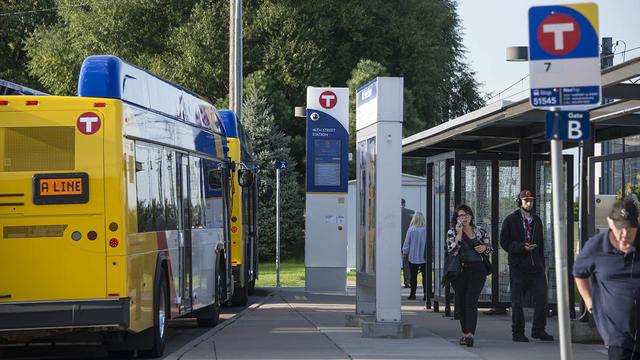Arterial bus rapid transit (BRT) has gained momentum in the Twin Cities as a less-expensive alternative to light-rail transit. However, this expansion of BRT has also raised concerns that the new lines will spur an increase in housing values and neighborhood gentrification, potentially displacing low-income residents.
A new study led by Jason Cao, a professor with the Humphrey School of Public Affairs, eases these concerns: It found that the A Line BRT route encouraged ridership but had no effect on housing values.
“We based the study design on a previous study we conducted that showed the Green Line light rail did cause property values to increase,” says Cao. “We wanted to see if deploying BRT lines would lead to a similar decrease in housing affordability, which could result in the displacement of lower-income residents along the transit corridors and limit their access to opportunities, transit, and existing social networks.”
The A Line BRT began service in mid-2016; it serves a nine-mile corridor in Ramsey County along Highway 51/Snelling Avenue, connecting the Rosedale Transit Center to the 46th Street Station on the Blue Line light rail.
Primary goals for the A Line, which replaced three existing local bus routes, were to increase efficiency and speed using traffic signal priority and shortened headways, and to improve the experience of riders by adding station amenities like those at light-rail stations.
To determine whether the addition of the A Line increased property values, researchers conducted a before-and-after analysis of housing sales data, comparing the A Line corridor with two control corridors that have been identified as future planned BRT routes in Ramsey County.
“After controlling for correlates of housing prices such as the number of bedrooms and floors, garages, and distance to downtown St. Paul, we concluded that the A Line had not affected housing values,” says Jack Lyle Benson, a graduate student in the Department of Civil, Environmental, and Geo- Engineering advised by Cao on the project.
Light rail vs. bus rapid transit
This finding led researchers to reflect on why the Green Line light rail had increased property values while the A Line did not—and they uncovered several possible explanations. First, the Green Line was supported by zoning changes and parking reductions, but no similar transit-supportive land-use policies were adopted for the A Line. In addition, a field survey revealed that some car drivers in the A Line corridor viewed the line as regular buses and did not notice the service changes. Finally, the A Line may be regarded as less permanent than light-rail transit.
“The Green Line operates on rail tracks whereas the A Line operates in mixed traffic,” Cao says. “As a result, home buyers and developers may view the A Line as less permanent than a light-rail line and see paying a premium for potentially temporary access as risky.”
While the study findings alleviate the displacement concerns, Cao says it may signal challenges for meeting ridership growth targets in the future.
“The A Line exceeded ridership projections in 2017 without increasing house prices, so objectively it is doing what it was designed to—serving the people who call that area home without destabilizing the housing market,” he says. “However, without value uplift and land development along the A Line, reaching the goal of 8,000 daily riders by 2030 will be challenging.”
“This was a fun and interesting study to conduct and view the result [of],” adds Benson, now a trainee-graduate engineer with MnDOT’s Metro District. “The question, although not too complex, does have a lot of meaningful connotations for the future of public transportation and residential living for the general public.”
This story was originally published by the Center for Transportation Studies.



